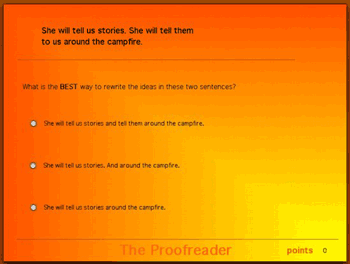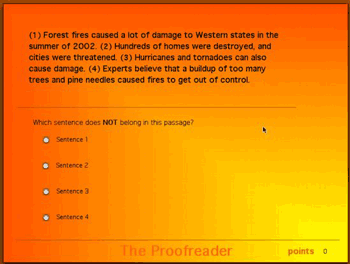Review: Shareware Roundup
Reading, Writing, and Arithmetic: Educational Tools
Issa 1.0.2
Ben Haller named this computerized version of the fridge poetry kit after his favorite poet, Kobayashi Issa (1763-1827). This program, although great for frustrated poets, will also help kids click into their creative side. Simply point and click on a word, or group of words, and drag to another word or words to create a haiku poem.
Here’s my poetic attempt:

I love reading haiku poems, but just can’t write them.
Issa also comes with a really cool feature: Define Tiles. Highlight a word tile and select Define Tiles from the Edit menu. Your browser will open up and go directly to dictionary.reference.com to give you the definition and pronunciation of the word. This is great for helping kids learn the meaning of new words.
Issa comes with three wordlists: Standard, Celebrities, and Harry Potter. Use the Standard wordlist (with verbs, adjectives, articles, etc.) to create poems,, Merge one of the name wordlists, or download even more wordlists. You can also add a new word to a wordlist, as well as change the font, size, and color of the word tiles.
You can also find matching tiles (it’s hard to find words that are the same when they’re plastered all over your desktop) or make a duplicate of a word.
Issa is really a worthwhile program. It includes Help online and a page to display your poems. However, if you don’t like a messy desktop, it might make you a little crazy. Of course, you can place all the word tiles in a neat little pile at the side somewhere, but that might take a while…
Proofreader 2.1.1

Developer: Mattson Software
Price: $5
Requirements: PowerPC-based Mac with Mac OS 8.6 and CarbonLib or Mac OS X
Do your kids need help with grammar? Proofreader 2.1.1 is here to help. This program is a fun way to help them brush up on their proofreading and grammar skills. It works in a simple multiple choice format with over 100 examples.
By reading a story, Proofreader goes through the story sentence by sentence offering three options to change something in the sentence that will make it grammatically correct. If you choose the correct selection, an explanation of why it is right appears at the bottom of the screen. You then can move on to the next sentence. If your selection is incorrect, “Try Again” appears at the side of the sentence and you get another go.
In this example below, you are asked to figure out which is the best way to combine the two sentences. Choose from one of the three options.

Again, in the multiple choice format, you are given the “one of these things doesn’t belong” option. Below is a four-sentence paragraph, but one of the sentences doesn’t fit. Choose the sentence that does not belong.

There is also an “Is It Complete” section, where you have to identify complete and incomplete sentences.
Overall, Proofreader is a great program to help teach kids about spotting grammar mistakes and explaining why the correct answer is correct. (Hey, it might even help clear up some of your own sticky grammar questions.) It’s obvious that proofreading is a needed skill in teaching kids to edit their own work and the work of others. Personally, I think it is especially timely since the use of e-mail and Web sites has, in some sense, eradicated any sense of grammar and punctuation.
FlashMath 1.0

Developer: St. Clair Software
Price: $15
Requirements: Mac OS 8.1 with CarbonLib 1.1.1 or Mac OS X 10.1
This unique flash card game, designed and written by Ben Gotow, teaches basic math skills: multiplication, division, addition, and subtraction. While a student is on the computer, FlashMath “intermittently interrupts their computer play to quiz them on a set of flash cards.” The score the student gets on the quiz determines how long he can continue to use the computer before the next quiz.
Although ideally for a classroom setting, it’s easy to use when the kids are on the computer at home. You (teacher/parent) set up the questions using a password, so a student can’t quit the program or change the questions. Create the questions you want to quiz your kids/students on: just do times tables or have all four operations (+, -, x, /). More than one child at home? Customize the questions for each one as each child logs into her own personal questions. There are also report cards to let you keep track of the child’s progress.
Ten questions drop down onto the desktop one by one. Type in the answer and press return. If you make a mistake, but know the correct answer (before you hit Return), just hit the Delete button to erase the incorrect answer and retype. If you answer incorrectly, FlashMath will answer for you (in red) so you know the correct answer. Hit Return and continue to the next question.

The red number indicates the correct answer. If you get all 10 questions right, the following message appears at the end of the quiz:
“Good Job! You got 10 out of 10 correct! You have 30 minutes until the next quiz.”
However, if you get any wrong, there’s less time until your next quiz: “Good Job! You got 5 out of 10 correct! You have 15 minutes until the next quiz.”
FlashMath is certainly a good way to learn fast math facts, however, there is no timer. I think this game would be ideal if there were a time limit, since most of these number facts must be learned before proceeding to more challenging math, i.e., multiplication should be automatic in order to tackle long division.
Aside from the timer, this computerized version of flashcards beats the way we used to do it: A student would move to each desk (up and down the rows) and whoever answered the fastest would proceed to the next desk. FlashMath is a less competitive way to learn facts and will probably not intimidate students if they have to go peer-to-peer.
Also in This Series
- Count Your Pennies · February 2003
- Reading, Writing, and Arithmetic: Educational Tools · January 2003
- Scrabble and Boggle · August 2002
- Weblog Tools · June 2002
- Financial Help · January 2002
- Games for Mac OS X · December 2001
- Screensavers · October 2001
- Stickies and Notepads—Part Two · July 2001
- Stickies and Notepads—Part One · June 2001
- Complete Archive

Reader Comments (0)
Add A Comment